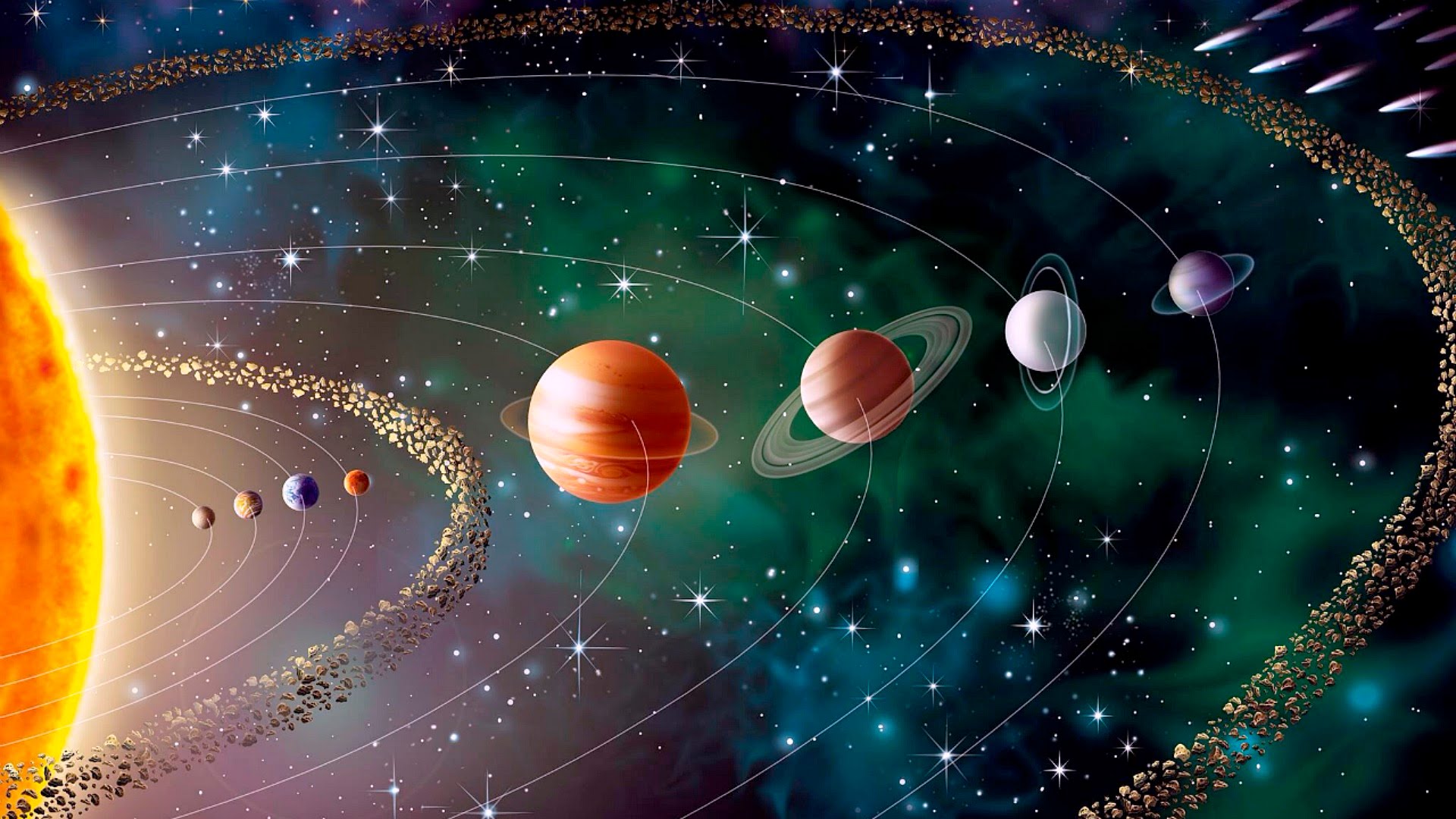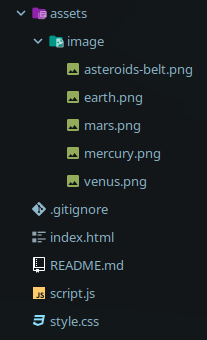Countdown to new year

La astronomía y la programación son dos de mis pasiones que en esta ocasión he decidido juntar. Con este objetivo crearemos una web sencilla para llevar la cuenta regresiva de cuantos días faltan hasta el nuevo año simulando el movimiento del planeta tierra. El demo se puede apreciar en el siguiente link https://yacosta738.github.io/countdown-to-new-year/

Lo primero es crear un fichero style.css donde se define el estilo y la órbita de cada planeta:
html {
box-sizing: border-box;
}
html *,
html *:before,
html *:after {
box-sizing: inherit;
}
body {
display: flex;
justify-content: center;
align-items: center;
width: 100vw;
height: 100vh;
overflow: hidden;
font-size: 62.5%;
background-color: #121212;
font-family: Arial, Helvetica, sans-serif;
margin: 0;
padding: 0;
}
.solar-system {
position: relative;
width: 100%;
max-width: 700px;
padding-top: 100%;
right: -50%;
}
@media (min-width: 700px) {
.solar-system {
padding-top: 700px;
}
}
/*** ORBITS ***/
.orbit {
position: absolute;
top: 50%;
left: 50%;
border: 2px dotted rgba(84 84 84 / 15%);
border-radius: 100%;
transform: translate(-50%, -50%);
}
.orbit-sun {
width: calc(50%);
height: calc(50%);
border: 1px dotted #ff6600;
background: #ffcc00;
}
.orbit-sun:before {
content: "";
background: #ff660017;
width: 99%;
height: 99%;
display: block;
margin-left: 0.5%;
margin-top: 0.5%;
border-radius: 100%;
box-shadow: 0 0 10em 5em #ff66006b, 0 0 100px 50px #ff66006b inset, 0 0 10px 5px #ffcc00f2;
}
.orbit.orbit-sun:after {
content: "SUN";
color: #ffa200;
top: 50%;
position: absolute;
left: -3.5em;
}
.orbit-mercury {
width: calc(100%);
height: calc(100%);
transform: translate(-50%, -50%);
}
.orbit-venus {
width: calc(150%);
height: calc(150%);
transform: translate(-50%, -50%);
}
.orbit-earth {
width: calc(200%);
height: calc(200%);
}
.orbit-earth:after {
content: "";
border: 2px solid red;
width: 1em;
height: 1em;
display: block;
position: relative;
border-color: #54cbeb #54cbeb transparent transparent;
transform: rotate(-50deg);
border-width: 2px 2px 0 0;
top: 52.75%;
left: -0.5em;
-webkit-animation: blinker 2s linear infinite;
animation: blinker 2s linear infinite;
}
.orbit-mars {
width: calc(280%);
height: calc(280%);
transform: translate(-50%, -50%);
}
.orbit-asteroids {
width: calc(380%);
height: calc(380%);
transform: translate(-50%, -50%) rotate(0deg);
}
/*** PLANETS ***/
.planet {
position: absolute;
top: 50%;
border-radius: 100%;
opacity: 0;
transform: translateY(-50%);
transition: opacity 0s ease 0s;
}
.planet-mercury {
left: -6px;
width: 10px;
height: 10px;
transition-duration: 1s;
background: #bcc1c9;
}
.planet-venus {
left: -8px;
width: 14px;
height: 14px;
transition-duration: 2s;
background: #ec5f24
}
.planet-earth {
left: -13px;
width: 24px;
height: 24px;
transition-duration: 3s;
z-index: 1;
}
.planet-mars {
left: -9px;
width: 18px;
height: 18px;
transition-duration: 4s;
background: #d83e3c;
}
.planet-asteroids {
left: -38px;
width: 308px;
height: 1500px;
transition: all 5s ease 0s;
}
.planet-mercury:before {
content: "MERCURY";
color: #bcc1c9;
margin-left: 15px;
top: 0px;
position: absolute;
height: 10px;
line-height: 10px;
}
.planet-venus:before {
content: "VENUS";
color: #ec5f24;
margin-left: 21px;
top: 1px;
position: absolute;
height: 14px;
line-height: 14px;
}
.planet-earth:before {
content: "EARTH";
color: #54cbeb;
margin-left: 29px;
top: 1px;
position: absolute;
height: 24px;
line-height: 24px;
}
.planet-mars:before {
content: "MARS";
color: #d83e3c;
margin-left: 23px;
top: 1px;
position: absolute;
height: 18px;
line-height: 18px;
}
.planet-asteroids:before {
content: "ASTEROID BELT";
color: #666666;
margin-left: 8em;
top: 36.75%;
position: absolute;
}
.planet-mars:after, .planet-venus:after, .planet-mercury:after, .planet-earth:after {
content: "";
background: linear-gradient(105deg, rgba(0,0,0,1), rgba(0,0,0,0.6), transparent, transparent);
display: block;
width: 100%;
height: 100%;
border-radius: 100%;
box-shadow: 0 0 3px 2px #ffffff26;
opacity: 0.8;
position: absolute;
top: 0;
left: 0;
}
.planet-earth:after {
box-shadow: 0 0 5px 3px #54cbeb5c;
}
.planet img {
width: 100%;
}
/*** SELECTED DAYS ***/
.new-year-line, .winter-solstice-line {
width: 12em;
border-bottom: 2px dotted white;
position: absolute;
left: -13.35em;
top: 50%;
z-index: -1;
color: white;
margin-top: -13px;
margin-left: -50%;
height: 14px;
line-height: 1em;
}
.new-year-line:after, .winter-solstice-line:after {
content: "";
width: 28px;
height: 28px;
display: block;
float: right;
position: absolute;
background: #ffffff00;
right: -28px;
top: -1px;
border: 2px dotted #fff;
border-radius: 100%;
}
.winter-solstice-line {
margin-top: 120px;
left: -12.05em;
}
#cronoNewYear, #cronoWinterSolstice {
left: 0;
position: absolute;
color: #fff;
width: 100%;
bottom: -17px;
font-size: 1.1em;
}
#cronoNewYear span, #cronoWinterSolstice span {
font-size: 0.75em;
color: #666;
}
/*** WARNING ***/
#warning {
position: fixed;
left: 2em;
bottom: 2em;
background: rgb(0 0 0 / 0.75);
height: 5em;
width: 45em;
font-size: 1.35em;
color: #ffa200;
z-index: 3;
text-transform: uppercase;
padding: 0;
text-align: center;
display: flex;
justify-content: center;
align-items: center;
}
#warning:before {
content: " ! ";
z-index: 2;
font-size: 1.9em;
margin-left: 1.15em;
color: #ffa200;
font-weight: bold;
margin-top: 5px;
}
#warning:after {
content: "";
background: #ffa200;
position: absolute;
left: 0;
width: 5em;
height: 5em;
z-index: 0;
}
#warning p {
display: block !important;
float: left;
width: 100%;
margin: 0 !important;
padding-left: 2.5em;
}
#warning p:before {
content: "";
position: absolute;
z-index: 1;
border: 1.75em solid transparent;
border-bottom: 2.85em solid #040404;
left: 0.775em;
top: -0.75em;
}
#reload {
background: rgb(255 162 0);
border: 0;
border-radius: 1px;
padding: 0.5em 0.75em;
margin-left: 1.5em;
cursor: pointer;
outline: none;
}
#reload:hover {
background: #54cbeb;
}
/* ANIMATIONS */
@-webkit-keyframes blinker {
0% { opacity:0; top:52.85%;}
40% { opacity:1; top:51%; }
50% { opacity:0; top:51%; }
60% { opacity:1; top:51%; }
100% { opacity:0; top:48.25%;}
}
@keyframes blinker {
0% { opacity:0; top:52.85%;}
40% { opacity:1; top:51%; }
50% { opacity:0; top:51%; }
60% { opacity:1; top:51%; }
100% { opacity:0; top:48.25%;}
}
@-webkit-keyframes spin {
from {transform: rotate(0deg) }
to {transform: rotate(-360deg);}
}
@keyframes spin {
from {transform: rotate(0deg) }
to {transform: rotate(-360deg);}
}
Después creamos el fichero script.js donde se define toda la lógica para calcular la cantidad de días que faltan para el nuevo año:
//prevent loading error
document.getElementById('warning').remove();
//short getElementById
elem = function (id) {
return document.getElementById(id);
}
//count until date
const newYearDate = new Date(`Jan 1, ${new Date().getFullYear() + 1} 00:00:00`).getTime();
//title angles
const todayDate = new Date().getTime();
const todaySecondsLeft = (newYearDate - todayDate) / 1000;
const todayDays = parseInt(todaySecondsLeft / 86400);
const randMer = Math.floor(Math.random() * (4 - 1 + 1)) + 1;
const randVen = Math.floor(Math.random() * (10 - 4 + 1)) + 4;
const randMar = Math.floor(Math.random() * (16 - 8 + 1)) + 8;
const style = document.createElement('style');
style.innerHTML = '.orbit-mercury {transform: translate(-50%, -50%) rotate(' + randMer + 'deg)} .orbit-venus {transform: translate(-50%, -50%) rotate(' + randVen + 'deg)} .orbit-mars {transform: translate(-50%, -50%) rotate(' + randMar + 'deg)} .planet-mercury {transform:rotate(-' + randMer + 'deg)} .planet-venus {transform:rotate(-' + randVen + 'deg)} .planet-mars {transform:rotate(-' + randMar + 'deg)} .planet-earth {transform:rotate(' + todayDays + 'deg)} .planet-venus {transform:rotate(-' + randVen + 'deg)} ';
document.head.appendChild(style);
//countdown vars
let days, hours, minutes, seconds;
//countdown
const countDown = setInterval(function () {
const rightNow = new Date().getTime();
const timeTo = newYearDate - rightNow;
days = Math.floor(timeTo / (1000 * 60 * 60 * 24));
hours = Math.floor((timeTo % (1000 * 60 * 60 * 24)) / (1000 * 60 * 60));
minutes = Math.floor((timeTo % (1000 * 60 * 60)) / (1000 * 60));
seconds = Math.floor((timeTo % (1000 * 60)) / 1000);
if (hours < 10) hours = "0" + hours;
if (minutes < 10) minutes = "0" + minutes;
if (seconds < 10) seconds = "0" + seconds;
elem("cronoNewYear").innerHTML = days + " <span>DAYS</span> " + hours + ":" + minutes + ":" + seconds + " <span>LEFT</span>";
let newDays;
if (days < 0) {
elem("cronoNewYear").style.display = 'none';
newDays = days.toString().substr(1);
} else {
newDays = "-" + days;
}
elem("position-earth").style.transform = 'translate(-50%, -50%) rotate(' + newDays + 'deg';
let solsDays;
const cDays = days - 11;
if (cDays < 0) {
elem("cronoWinterSolstice").style.display = 'none';
} else {
solsDays = cDays
}
elem("cronoWinterSolstice").innerHTML = solsDays + " <span>DAYS</span> " + hours + ":" + minutes + ":" + seconds + " <span>LEFT</span>";
const opacityList = document.querySelectorAll('.planet');
for (let i = 0; i < opacityList.length; i++) {
opacityList[i].style.opacity = '1';
}
if (timeTo < 0) {
clearInterval(countDown);
}
}, 1000);
Por último se crea un fichero index.html que contendrá todo el código html de nuestra página web. El documento html comienza con la definición del tipo de documento seguido por el lenguaje de la página, en la sección del encabezado encontramos el título, algunos metadatos así como la importación de los estilos de la página. En el cuerpo del documento hacemos usos de las clases creadas previamente para poder visualizar los planetas y sus órbitas. Al final importamos el fichero javascript creado con anterioridad:
<!DOCTYPE html>
<html lang="en" >
<head>
<meta charset="UTF-8">
<title>Countdown to New Year </title>
<link rel="stylesheet" href="https://cdnjs.cloudflare.com/ajax/libs/normalize/5.0.0/normalize.min.css">
<link rel="stylesheet" href="./style.css">
</head>
<body>
<!-- partial:index.partial.html -->
<div class="solar-system">
<div class="orbit orbit-sun"></div>
<div class="orbit orbit-mercury" id="position-mercury">
<div class="planet planet-mercury" id="opacity-mercury">
<img src="assets/image/mercury.png" alt="mercury">
</div>
</div>
<div class="orbit orbit-venus" id="position-venus">
<div class="planet planet-venus" id="opacity-venus">
<img src="assets/image/venus.png" alt="venus">
</div>
</div>
<div class="orbit orbit-earth" id="position-earth">
<div class="planet planet-earth" id="opacity-earth">
<img src="assets/image/earth.png" alt="earth">
</div>
</div>
<div class="orbit orbit-mars" id="position-mars">
<div class="planet planet-mars" id="opacity-mars">
<img src="assets/image/mars.png" alt="mars">
</div>
</div>
<div class="orbit orbit-asteroids" id="position-asteroids">
<div class="planet planet-asteroids" id="opacity-asteroids">
<img src="assets/image/asteroids-belt.png" alt="asteroids">
</div>
</div>
<div class="new-year-line">NEW YEAR <span id='cronoNewYear'></span></div>
<div class="winter-solstice-line">WINTER SOLSTICE <span id="cronoWinterSolstice"></span></div>
</div>
<div id="warning"><p>it seems that the earth has gone out of its orbit... <button id="reload" onclick="location.reload()">RE-ORBIT</button></p></div>
<!-- partial -->
<script src="./script.js"></script>
</body>
</html>

Todo el código se puede descargar desde GitHub en el siguiente link https://github.com/yacosta738/countdown-to-new-year
